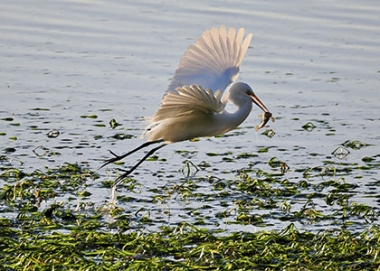
Northwest Zone
Table of Contents
Recreation Report

NW WILDLIFE VIEWING
December 18, 2025
Tillamook County
Birds
Large numbers of waterfowl arrive before November and will likely spend the rest of the winter here. They will raft up out in the middle of most local estuaries on calm days but will move around with the incoming tide and on windy days. Many species of diving ducks can be seen on area lakes and bays. Likewise, many migrating geese are beginning to arrive and are using area fields, along with many egrets, herons and wintering raptors. Pastures and fields are heavily used by a variety of waterfowl when flooded and by wading birds under nearly any conditions. At this time of year, herons and egrets can be seen hunting amphibians and small mammals in local farm fields.
Bald eagle pairs can be seen near estuaries and rivers.
Clatsop County
Birds
The Columbia River estuary is stopover spot #1 for migrating ducks and geese during November. Puddle ducks will more likely be found around flooded fields and creek mouths, while diving ducks will be using deeper water in lakes, bays and sometimes larger sloughs. Bald eagles will be found nearby, looking to pick off the unwary or injured.
Coastal storm-watchers may find interesting pelagic species pushed closer to shore by the rough weather. Some species which may be viewed during and just after storms include skuas, jaegers, petrels, storm petrels, shearwaters, fulmars and even the occasional albatross. These species are best viewed from headlands (also the best spots for storm-watching) with good optics on clear days just following storm activity and high winds.
Pastures and fields are heavily used by a variety of waterfowl when flooded and by wading birds under nearly any conditions. Peeps can be extremely difficult to identify due to small size and subtle differences in plumage – a good guide and optics are a must.
Elk viewing has been excellent at Jewell Meadows Wildlife Area. The best viewing continues to be in the mornings from 9:00 AM until noon and again in the evenings. With the cooler weather elk are frequently visible throughout the day. Good places to look are the Fishhawk Tract along Hwy 202 and the Beneke Tract along the first 1.5 miles of Beneke Creek Road.
Jewell Meadows Wildlife Area started its' winter elk feeding program on December 1. Elk are provided a supplemental diet of alfalfa hay each day. Feeding time is between 9 and 10 AM most days. This supplemental feed holds elk in the open meadows longer during the day and offers better viewing. Staff try to feed closer to the viewing areas on weekends.
Other wildlife to watch for include songbirds in and around the viewing area bird feeders, coyotes running across the open meadows, and bald eagles perched high in the trees near the creeks. Several species of water birds have been at the seasonal wetlands along Beneke road. Listen and watch for pileated woodpeckers near the main viewing area.
Jewell Meadows Wildlife Area started taking reservations for the winter elk tours on December 1 and all reservations have been completely filled for the entire 3-month tour season. Brochures with maps are available at the main viewing area kiosk. Visitors are reminded that areas posted as "Wildlife Refuge" are closed to public entry. Additionally, posted portions of the Beneke Tract are closed to public entry during any Saddle Mt. unit elk season including Archery season. Closure dates are August 1 through March 31 (see big game regulations for exceptions).
A parking permit is required to park at Jewell Meadows Wildlife Area. Find out how to buy a parking permit.
Lincoln County/western Lane County
Several species of birds, such as herons, osprey, eagles, pelicans, pintails, widgeon, mallards and teal, use our coastal estuaries and lakes for foraging and resting. They can often be found along the edges of the estuary and roosting in adjacent trees. Some good places to check out are the mouth of the Salmon River, Devils Lake, Siletz Bay, Yaquina Bay, Alsea Bay, Yachats River mouth, multiple lakes around Florence and the mouth of the Siuslaw River. Take your binoculars and try to catch a glimpse of these birds as they begin their migration south.
